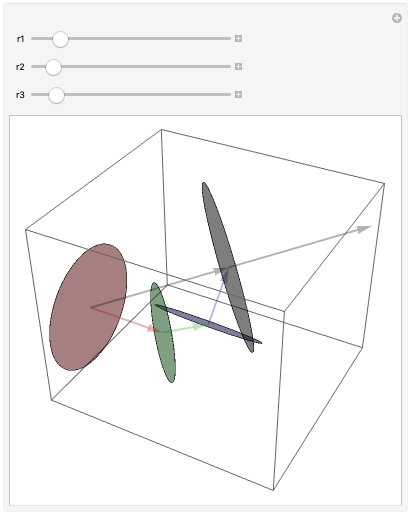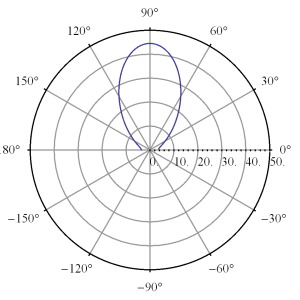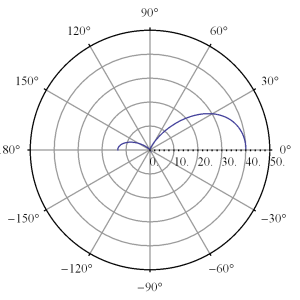[Click here for a PDF of this post with nicer formatting]
Q: \( L_y \) perturbation. [1] pr. 5.17
Find the first non-zero energy shift for the perturbed Hamiltonian
\begin{equation}\label{eqn:LyPerturbation:20}
H = A \BL^2 + B L_z + C L_y = H_0 + V.
\end{equation}
A:
The energy eigenvalues for state \( \ket{l, m} \) prior to perturbation are
\begin{equation}\label{eqn:LyPerturbation:40}
A \Hbar^2 l(l+1) + B \Hbar m.
\end{equation}
The first order energy shift is zero
\begin{equation}\label{eqn:LyPerturbation:60}
\begin{aligned}
\Delta^1
&=
\bra{l, m} C L_y \ket{l, m} \\
&=
\frac{C}{2 i}
\bra{l, m} \lr{ L_{+} – L_{-} } \ket{l, m} \\
&=
0,
\end{aligned}
\end{equation}
so we need the second order shift. Assuming no degeneracy to start, the perturbed state is
\begin{equation}\label{eqn:LyPerturbation:80}
\ket{l, m}’ = \sum’ \frac{\ket{l’, m’} \bra{l’, m’}}{E_{l,m} – E_{l’, m’}} V \ket{l, m},
\end{equation}
and the next order energy shift is
\begin{equation}\label{eqn:LyPerturbation:100}
\begin{aligned}
\Delta^2
&=
\bra{l m} V
\sum’ \frac{\ket{l’, m’} \bra{l’, m’}}{E_{l,m} – E_{l’, m’}} V \ket{l, m} \\
&=
\sum’ \frac{\bra{l, m} V \ket{l’, m’} \bra{l’, m’}}{E_{l,m} – E_{l’, m’}} V \ket{l, m} \\
&=
\sum’ \frac{ \Abs{ \bra{l’, m’} V \ket{l, m} }^2 }{E_{l,m} – E_{l’, m’}} \\
&=
\sum_{m’ \ne m} \frac{ \Abs{ \bra{l, m’} V \ket{l, m} }^2 }{E_{l,m} – E_{l, m’}} \\
&=
\sum_{m’ \ne m} \frac{ \Abs{ \bra{l, m’} V \ket{l, m} }^2 }{
\lr{ A \Hbar^2 l(l+1) + B \Hbar m }
-\lr{ A \Hbar^2 l(l+1) + B \Hbar m’ }
} \\
&=
\inv{B \Hbar} \sum_{m’ \ne m} \frac{ \Abs{ \bra{l, m’} V \ket{l, m} }^2 }{
m – m’
}.
\end{aligned}
\end{equation}
The sum over \( l’ \) was eliminated because \( V \) only changes the \( m \) of any state \( \ket{l,m} \), so the matrix element \( \bra{l’,m’} V \ket{l, m} \) must includes a \( \delta_{l’, l} \) factor.
Since we are now summing over \( m’ \ne m \), some of the matrix elements in the numerator should now be non-zero, unlike the case when the zero first order energy shift was calculated above.
\begin{equation}\label{eqn:LyPerturbation:120}
\begin{aligned}
\bra{l, m’} C L_y \ket{l, m}
&=
\frac{C}{2 i}
\bra{l, m’} \lr{ L_{+} – L_{-} } \ket{l, m} \\
&=
\frac{C}{2 i}
\bra{l, m’}
\lr{
L_{+}
\ket{l, m}
– L_{-}
\ket{l, m}
} \\
&=
\frac{C \Hbar}{2 i}
\bra{l, m’}
\lr{
\sqrt{(l – m)(l + m + 1)} \ket{l, m + 1}
–
\sqrt{(l + m)(l – m + 1)} \ket{l, m – 1}
} \\
&=
\frac{C \Hbar}{2 i}
\lr{
\sqrt{(l – m)(l + m + 1)} \delta_{m’, m + 1}
–
\sqrt{(l + m)(l – m + 1)} \delta_{m’, m – 1}
}.
\end{aligned}
\end{equation}
After squaring and summing, the cross terms will be zero since they involve products of delta functions with different indices. That leaves
\begin{equation}\label{eqn:LyPerturbation:140}
\begin{aligned}
\Delta^2
&=
\frac{C^2 \Hbar}{4 B} \sum_{m’ \ne m} \frac{
(l – m)(l + m + 1) \delta_{m’, m + 1}
–
(l + m)(l – m + 1) \delta_{m’, m – 1}
}{
m – m’
} \\
&=
\frac{C^2 \Hbar}{4 B}
\lr{
\frac{ (l – m)(l + m + 1) }{ m – (m+1) }
–
\frac{ (l + m)(l – m + 1) }{ m – (m-1)}
} \\
&=
\frac{C^2 \Hbar}{4 B}
\lr{
–
(l^2 – m^2 + l – m)
–
(l^2 – m^2 + l + m)
} \\
&=
-\frac{C^2 \Hbar}{2 B} (l^2 – m^2 + l ),
\end{aligned}
\end{equation}
so to first order the energy shift is
\begin{equation}\label{eqn:LyPerturbation:160}
\boxed{
A \Hbar^2 l(l+1) + B \Hbar m \rightarrow
\Hbar l(l+1)
\lr{
A \Hbar
-\frac{C^2}{2 B}
}
+ B \Hbar m
+\frac{C^2 m^2 \Hbar}{2 B} .
}
\end{equation}
Exact perturbation equation
If we wanted to solve the Hamiltonian exactly, we’ve have to diagonalize the \( 2 m + 1 \) dimensional Hamiltonian
\begin{equation}\label{eqn:LyPerturbation:180}
\bra{l, m’} H \ket{l, m}
=
\lr{ A \Hbar^2 l(l+1) + B \Hbar m } \delta_{m’, m}
+
\frac{C \Hbar}{2 i}
\lr{
\sqrt{(l – m)(l + m + 1)} \delta_{m’, m + 1}
–
\sqrt{(l + m)(l – m + 1)} \delta_{m’, m – 1}
}.
\end{equation}
This Hamiltonian matrix has a very regular structure
\begin{equation}\label{eqn:LyPerturbation:200}
\begin{aligned}
H &=
(A l(l+1) \Hbar^2 – B \Hbar (l+1)) I \\
&+ B \Hbar
\begin{bmatrix}
1 & & & & \\
& 2 & & & \\
& & 3 & & \\
& & & \ddots & \\
& & & & 2 l + 1
\end{bmatrix} \\
&+
\frac{C \Hbar}{i}
\begin{bmatrix}
0 & -\sqrt{(2l-1)(1)} & & & \\
\sqrt{(2l-1)(1)} & 0 & -\sqrt{(2l-2)(2)}& & \\
& \sqrt{(2l-2)(2)} & & & \\
& & \ddots & & \\
& & & 0 & – \sqrt{(1)(2l-1)} \\
& & & \sqrt{(1)(2l-1)} & 0
\end{bmatrix}
\end{aligned}
\end{equation}
Solving for the eigenvalues of this Hamiltonian for increasing \( l \) in Mathematica (sakuraiProblem5.17a.nb), it appears that the eigenvalues are
\begin{equation}\label{eqn:LyPerturbation:220}
\lambda_m = A \Hbar^2 (l)(l+1) + \Hbar m B \sqrt{ 1 + \frac{4 C^2}{B^2} },
\end{equation}
so to first order in \( C^2 \), these are
\begin{equation}\label{eqn:LyPerturbation:221}
\lambda_m = A \Hbar^2 (l)(l+1) + \Hbar m B \lr{ 1 + \frac{2 C^2}{B^2} }.
\end{equation}
We have a \( C^2 \Hbar/B \) term in both the perturbative energy shift, and the first order expansion of the exact solution. Comparing this for the \( l = 5 \) case, the coefficients of \( C^2 \Hbar/B \) in the perturbative solution are all negative \( -17.5, -17., -16.5, -16., -15.5, -15., -14.5, -14., -13.5, -13., -12.5 \), whereas the coefficient of \( C^2 \Hbar/B \) in the first order expansion of the exact solution are \( 2 m \), ranging from \( [-10, 10] \).
References
[1] Jun John Sakurai and Jim J Napolitano. Modern quantum mechanics. Pearson Higher Ed, 2014.
Like this:
Like Loading...




